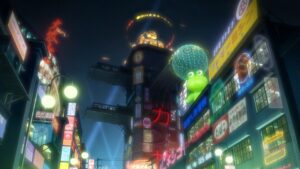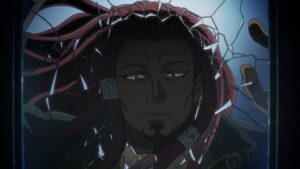It’s often said that TV anime dump a disproportionate amount of time and talent into their first episodes, leading to a noticeable drop-off in episode 2. As a piece of conventional wisdom, it makes sense – producers want to hook as wide an audience as possible, as early as possible, so the extra effort would be warranted. And yet, we’re seeing a bunch of exceptions to this rule of thumb in the fall 2020 season alone. Jujutsu Kaisen had a terrific second outing that convinced me to follow the show week to week, while Dragon Quest’s employment of 3DCG animation in episode 2 was a massive improvement on the first. And sure enough, here comes Akudama Drive with a follow-up that’s just as unhinged and action-packed as its premiere. It didn’t manage to top itself (that would have been an absurd feat), but these twenty minutes surely delivered on the promise I saw last week. If you consider realism to be an optional component of your anime intake, this may be the show for you.
I don’t plan to do a lot of recapping or synopsizing in talking about this series; Akudama Drive is better experienced than it is explained. Neither does it demand careful analysis, seeing as it features a cast of super-powerful caricatures doing awesome shit. But it did offer some context for its dystopian future in this episode, in the form of an educational video with cartoon narrators Usagi-chan and Same-kun. The long and short of its setting is that the Japanese provinces of Kanto and Kansai were at war long ago; Kanto won by dropping a bomb on Kansai, and now “gods and important people” live in the former province while the latter is segregated based on wealth. The farcical tone of the video signals that the mascots’ reverence for Kanto is misplaced, but that probably won’t factor into the story until we reach the second half of the anime. For now, it’s all about out of control airships, railgun motorcycles, and doctors who can sew their decapitated heads back onto their bodies.
Calling the cast a bunch of caricatures isn’t merely a dismissive term – the major characters in this show don’t have names. Instead, they’re referred to by their titles as Akudama, or major criminals of the Kansai region: Courier, Brawler, Hacker, etc. The female lead’s case is even more obscure – she’s listed on anime databases as “Ippanjin,” or “common person,” though she gives herself the title Swindler in order to blend in with the rabble. Swindler is clearly the audience surrogate, having no special skills of her own, and cowering in fear whenever one of the show’s explosive fight scenes breaks out in her vicinity. Her perpetually wide-eyed stare and panicked vocalizations aren’t too big a buzzkill, I’ve found, because her surroundings are just that intense. Now that she’s found herself in the company of lunatics, she’s got two paths to survival: get lucky or get good. Hopefully she pursues the second option in due time, rather than scrambling for cover whenever trouble arises. Still, I can’t blame her for exhibiting Headless Chicken Syndrome at this early stage.
In this episode, our merry band of Akudama hijacked an airship, crashed it into a hotel, planned a heist aboard a bullet train, and fought a pair of laser-sword-bearing executioners. That last scene was overflowing with style, making it an easy favorite for me. A lot of people will criticize it as being too visually busy, which is justifiable – the fight takes place in a variably-lit hotel room with a digital aquarium for a floor, so it’s a far cry from your average shounen brawl. But I found it to be quite strong at cutting between the hand-to-hand combatants and sideline spectators, which made the whole thing feel of a piece. While Swindler and the pompadour-sporting Hoodlum were fretting behind an ugly purple couch, a piece of furniture rocketed over their heads to transition back to the action. The senior executioner coolly leaned against a countertop as the fight began, but darted into the fray with remarkable clarity as soon as his kouhai found herself in danger. All told, the scuffle had six participants, each of whom moved in and out of focus with flair, but also with purpose.
The animation was still very strong, as well (though not on the level of the two series I mentioned at the start of this post). Both the anime’s direction and the characters themselves move with inhuman quickness, so clustering most of the in-between frames around the key poses seems to be Akudama Drive’s secret sauce. Whenever Brawler and the junior executioner needed to close the distance during their fight, the show spent only a couple drawings on that motion; once the gap between them was eliminated, it put a lot more detail behind the movement of their limbs as they dodged and traded blows. Impact effects, smoke and debris were plentiful, and the moment when Doctor’s hand and neck were severed made good use of hand-drawn blood splatter (a rarity in TV animation). All of this is to say that I’m really impressed with the series’ production thus far. Watching Akudama Drive from week to week is like waiting for a pileup at a busy intersection, but so far the show’s looks haven’t crashed – let’s all say a quick prayer to whichever anime god you believe in that we can go 12 episodes without incident.





As a Dangan Ronpa fan, I’m looking forward to seeing how this unfolds, given that the story was written by the series’ creator, Kazutaka Kodaka and was produced by his new company. Given what I’ve seen of his work in the DR games with their twisty plots, this is going to be wild ride.
Im enjoying Akudama a lot so far. I’ve always had a softspot for characters that bullshit their way through life with a combination of luck and charisma. It’s why Ciaphas Cain, from the 40k novels, is one of my favorite characters. He is somehow human, and more than human in the same book and I hope Akudama pulls off the same thing here.
Meanwhile production wise, they somehow made a fight in a square box, AKA the hotel room, interesting. I loved the use of the watery floor, rippling everytime they took a step on it. Its simple but it adds a lot visually to an otherwise dull angle/room.